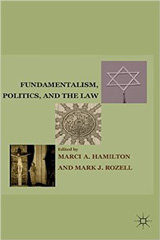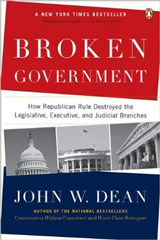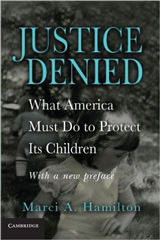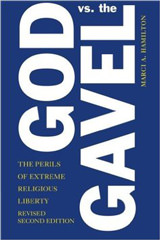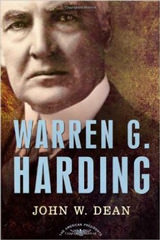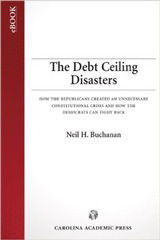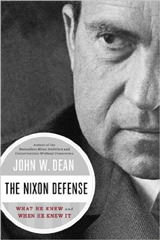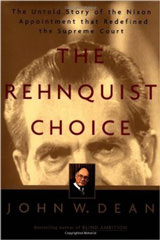Justia columnist and Cornell law professor Sherry Colb comments on two criminal law cases in which the U.S. Supreme Court has granted review. As Colb explains, the two cases together raise the following question: Does the Eighth Amendment’s cruel and unusual punishments ban prohibit mandatory sentences of life imprisonment without the possibility of parole (LWOP) for homicide offenses committed by fourteen-year-olds? In one case, the fourteen-year-old had suffered years of abuse and neglect, as well as severe poverty. In the other case, the fourteen-year-old apparently learned only on the way to a planned robbery that one of his accomplices was carrying a gun, and it was the accomplice who committed murder during the robbery, not the fourteen-year-old. (The fourteen-year-old was thus only charged with murder under the “felony murder” doctrine, based on his participation in a robbery that led to murder.) Colb explains that, in these two cases, the Court will need to consider the relationships among three relevant factors: (1) the capacity of an offender to behave morally; (2) the wrongfulness of the offender’s behavior; and (3) the harmful consequences of the offender’s actions. She describes the relevant prior Supreme Court precedents regarding juvenile offenders and other criminal law topics, and raises intriguing questions such as whether youth itself should be a mitigating factor to be taken into account in sentencing, in light of young teens’ demonstrably poor impulse control and susceptibility to pressure from others. Colb also covers the sentencing concepts of proportionality and discretion, and explains how they relate to these two cases. In addition, she describes—and, to some extent, challenges—the Supreme Court's “Death is different” jurisprudence, which singles out the death penalty for special notice despite the tremendous severity of an LWOP sentence, and the failure of an LWOP sentence to leave the offender hope for the future.
When you post an anonymous message on an Internet message board, how anonymous is it, really? Justia columnist and attorney Julie Hilden comments on a recent Illinois state court appellate decision regarding the First Amendment right to speak anonymously. The dispute at issue arose from a number of anonymous comments posted on a newspaper website's message board, and relating in part to a local election. The target of the comments sued for defamation (via his parent, as he was a minor). However, the Illinois court—after clarifying Illinois law pertaining to defamation cases involving an anonymous defendant—found that the statements at issue were not necessarily defamatory, but rather could, and should, be subject to an innocent interpretation. Hilden argues that while the court’s invocation of the innocent-construction rule here was dubious, the court was right to protect the anonymity of the message-board-poster defendant.
Justia columnist Vikram David Amar, and Justia guest columnist Alan Brownstein, both U.C., Davis law professors, comment on the latest ruling in the litigation regarding Proposition 8, the California anti-gay-marriage initiative. Amar and Brownstein begin by noting that this ruling holds that the initiative’s proponents have the authority to defend the initiative in California state court, now that elected representatives have declined to do so. They then summarize all the Prop. 8 litigation that has occurred thus far. In addition, they explain what may happen if this case reaches the U.S Supreme Court based on the standing issue it presents (that is, the issue of whether the parties at issue are legally able to bring this case). They cover a reason why the Supreme Court might decline to find federal standing: until now, initiative proponents have not been elected or specifically deputized by the people. Finally, they briefly discuss some other troubling questions regarding the Prop. 8 litigation that the California ruling did not address.
Justia columnist and attorney Julie Hilden explains why a case regarding the famous 2004 “Nipplegate” incident—involving Janet Jackson, Justin Timberlake, and the Superbowl—has returned to the U.S. Court of Appeals for the Third Circuit: An FCC crackdown led to a whopping fine for CBS, which is still being litigated. The Supreme Court recently sent the case back for reconsideration, in light of the High Court’s recent, related decision in FCC v. Fox Television Stations, Inc. But upon reconsideration, two judges on the three-judge Third Circuit panel reached essentially the same decision that they had reached on the first go-round, despite the High Court’s direction to take into account the Fox ruling. In light of that fact, Hilden suggests that the “Nipplegate” case may end up at the Supreme Court—for the Justices may be unhappy with the Third Circuit panel majority’s approach of reiterating its prior decision, while emphasizing certain points it made earlier even more, in light of Fox, rather than altering its approach with Fox in mind.
Justia columnist and U. Washington law professor Anita Ramasastry comments on recently-enacted state laws that cover the growing occurrence of “e-personation.” As Ramasastry explains, “e-personation” occurs when thieves, scam artists, people seeking revenge, or bullies use the Internet to pretend to be someone else—either by creating a fake Facebook or web profile, or by communicating via email with third parties under a false name. She notes that the object of e-personation is often to defraud, perhaps in order to gain the target’s confidential information. Ramasastry considers whether separate e-personation laws are really necessary, and contrasts California’s and New Jersey’s respective approaches to e-personation. She argues that, in most circumstances, it is not necessary for states to pass a special law to reach e-personation, since the laws already on the books will suffice. Noting that currently, only California, New York, and Texas have separate e-personation statutes, she urges other states not to follow suit and simply enforce the laws they already have. She also discusses the possible First Amendment issues raised by some applications of e-personation laws.
Justia columnist and Cornell law professor Michael Dorf comments on the evolution and role of the “scholar brief.” A scholar brief is an amicus (friend-of-the-court) brief submitted to a court—usually, the U.S. Supreme Court—by a law professor acting in his or her role as scholar, rather than advocate. Dorf notes that a column in The New York Times recently pointed to Harvard Law Professor Richard Fallon’s article draft questioning the value of scholar briefs, by suggesting that they are very often not particularly scholarly. In this column, Dorf considers why scholars’ amicus briefs have proliferated recently, and what light that proliferation sheds on the evolving relationship between the bench and the legal academy. In particular, Dorf connects the proliferation of scholar briefs to the increasing divide between legal scholarship in the academy, and the more practical work of the courts, including the Supreme Court. And yet, he notes that the academy’s work—contrary to the claims of some—actually does continue to have relevance to courts, in part by showing how disciplines such as economics and psychology can better illuminate the workings of the law.
In the second of a two-part series of columns raising questions about the legal effect of online ordination, Justia columnist and Hofstra law professor Joanna Grossman discusses whether persons who are ordained only by an online ministry, with no prerequisites for ordination but the payment of a fee, can legally perform marriages. Such online ministries include the Pastafarians (who belong to the Church of the Flying Spaghetti Monster), the Church of Body Modification, the Universal Life Church, and others. Grossman points out that in some states, such ordinations mean nothing, and thus, marriages performed by such “ministers” will not be valid. She focuses, especially, on New York, where the validity of such marriages is especially doubtful.
Justia columnist and former counsel to the president John Dean comments on the Occupy Wall Street movement, in light of his own experience with Vietnam War protests. During the war, Dean initially served as an associate deputy attorney general at the Justice Department, often acting as a mediator between the protesters and the government. Later, he served as Counsel to President Nixon and as the Nixon Administration’s top anti-war protest intelligence analyst. While Dean applauds and supports today’s Occupy Wall Street movement, he warns that the movement may encounter some of the same problems that the Vietnam War protesters faced. In particular, Dean observes that the Occupy Wall Street movement is likely to grow in size and duration. Indeed, he contends that—since the problems the Occupy Wall Street movement decries cannot be solved by a single action, such as ending a war—the movement’s duration has the potential to exceed that of the Vietnam War protests. Dean also regretfully predicts that the Occupy Wall Street movement will inevitably lead to violence, despite the fact that the overwhelming majority of the members of the movement absolutely do not want violence. Finally, Dean notes that today’s much faster communications technology may lead to a faster escalation toward violence, if violence does occur, than happened in the past. Thus, he concludes the challenge for the movement is to keep any violence that occurs isolated and contained.
In the wake of the child sexual abuse scandals at Penn State and The Citadel’s camp, and within the Catholic Church and other religious institutions, Marci Hamilton suggests a better approach to the reporting and investigation of child sexual abuse claims. Hamilton argues that there should be a universal obligation to report abuse to a hotline, and that those who call the hotline in good faith, to report suspected abuse, should be legally immune to defamation claims. (False claims, however, would be penalized.) The hotline responders would then alert the appropriate agency or agencies. Hamilton also advocates strong failure-to-report penalties. She cautions, though, that a reporting obligation will not be enough; investigations must be improved too—noting that there was a 1998 report from a child’s mother about alleged Penn State abuser Jerry Sandusky, and yet, that investigation went off-track. Hamilton explains why that investigation was, and why similar investigations can be, ineffective, and she urges that investigators and others must keep in mind that empirically, children rarely lie about sexual abuse. Moreover, Hamilton notes that mandatory reporting will not only protect children, but also institutions that would otherwise have been destroyed by scandal, and now have the chance to take quick, decisive action against abusers.
Justia columnist and Cornell law professor Sherry Colb offers an interesting perspective on the controversial U.S. Supreme Court ruling in Cavazos v. Smith. There, the High Court summarily reversed a decision of the U.S. Court of Appeals for the Ninth Circuit. The Ninth Circuit had granted a writ of habeas corpus to a grandmother who had been convicted—based on questionable evidence—of killing her grandson by shaking him violently. In her column, Colb focuses on two key issues that the case raised: (1) the extreme deference to state courts demanded by the Antiterrorism and Effective Death Penalty Act of 1996 (AEDPA); and (2) the Supreme Court’s limited role in reviewing decisions of the lower courts. Colb also explains why there may be genuine doubts here as to the guilt of the grandmother. For instance, she points out that medical knowledge in the years between the trial and today has cast doubt on the prosecution experts’ conclusions ruling out innocent explanations of the autopsy evidence. The Supreme Court, however, seems to have believed that the U.S. Court of Appeals for the Ninth Circuit, in ruling for Smith, was substituting its own judgment for that of the jury—leading the High Court to summarily reverse the habeas corpus grant.
In the second in a two-part series of columns on the Penn State alleged child sex abuse and failure-to-report scandal, Justia columnist and Hofstra law professor Joanna Grossman, and Justia guest columnist and U. Pittsburgh law professor Deborah Brake continue their commentary on a new and interesting legal aspect of the scandal. They argue that in addition to raising issues of criminal liability and civil tort liability, the alleged Penn State child abuse and the failure to report it may also raise issues under Title IX—the 1972 federal statute that prohibits recipients of federal funds from discriminating on the basis of sex in their educational programs and activities. Here, in Part Two of the series, Grossman and Brake discuss particular issues that may arise if a Title IX claim is brought: Does it make a difference if a given boy was abused only once, for liability purposes? Did the alleged Penn State abuse occur under “any education program or activity” as the statute requires? Does Title IX apply to the alleged harassment by Jerry Sandusky of these particular boys, who (obviously) were not Penn State students? In answering these questions, Grossman and Brake explain why, at the very minimum, the alleged sexual assaults that took place in the showers of the Penn State locker room or its sauna would, at least, fall within Title IX’s reach. In addition, they explain the legal issues regarding Penn State’s potential liability for the abuse, and look to the Grand Jury’s report to see if actual notice and deliberate indifference can be proven, as Title IX requires. Finally, Grossman and Brake note that, for several reasons, there are likely to be no statute-of-limitations issues here, despite the passage of time.
Justia guest columnist and Touro law professor Rodger Citron comments on former NPR reporter Snigda Prakash’s recent book on the Vioxx litigation and, especially, the Vioxx trial. The litigation, as Citron explains, followed manufacturer Merck’s withdrawal of Vioxx from the market in the face of evidence that those who took the drug faced an increased risk of heart attacks and strokes. Citron praises Prakash for making good use of her access to the plaintiffs’ legal team, and offering a vivid, compelling portrait of the trial, but notes that when she admittedly takes sides—beginning to root for the plaintiffs—her journalistic objectivity predictably suffers to some extent. In addition, Citron notes that he would have liked to hear more, in Prakash’s book, about the comprehensive settlement that will be the Vioxx dispute’s lasting legacy.
In the first in a two-part series of columns on the Penn State alleged child sex abuse and failure-to-report scandal, Justia columnist and Hofstra law professor Joanna Grossman, and Justia guest columnist and U. Pittsburgh law professor Deborah Brake comment on a new and interesting legal aspect of the scandal. They argue that in addition to raising issues of criminal liability and civil tort liability, the alleged Penn State child abuse and the failure to report it may also raise issues under Title IX—the 1972 federal statute that prohibits recipients of federal funds from discriminating on the basis of sex in their educational programs and activities. Grossman and Brake note that Title IX has been used in the past to address sexual harassment by teachers and coaches, and by third parties, and that such harassment can encompass sexual assault and rape. Title IX, they note, also reaches same-sex harassment. Based on the grand jury presentment, Grossman and Brake detail the allegations at issue. Based on Supreme Court precedent, they explain why the alleged conduct at issue could fit within the parameters of Title IX.
Justia guest columnist and U. Richmond law professor Carl Tobias comments on the lingering vacancies on the U.S. Court of Appeals for the District of Columbia Circuit, and urges that they be filled. Tobias explains why the D.C. Circuit has been called the nation’s second most important court, behind only the U.S. Supreme Court, and notes that D.C. Circuit judges, more than other federal Circuit Court judges, are especially likely to go on to become U.S. Supreme Court Justices. Tobias emphasizes the importance of President Obama’s soon choosing nominees for the open D.C. Circuit spots, and of the Senate’s expeditiously confirming those nominees, and thus transcending the typically contentious battles that have been fought in the past over this Circuit’s seats. He also explains some of the likely reasons why the President has only nominated one person thus far to fill a D.C. Circuit opening.
Justia columnist and U.C., Davis law professor Vikram David Amar comments on a recent, rare Supreme Court summary reversal. A summary reversal occurs when the Court summarily grants review and then reverses the federal circuit court’s decision without the benefit of full written briefs and oral arguments. In this instance, Amar suggests that the Court may have opted for summary reversal in light of its apparent annoyance with the U.S. Court of Appeals for the Ninth Circuit. In a criminal case in which a grandmother was accused of shaking her grandson to death, her defense was that the child died, instead, of Sudden Infant Death Syndrome. The Ninth Circuit sided with the grandmother, and reversed the conviction. The Supreme Court then twice directed the Ninth Circuit to reconsider its reversal, but the Ninth Circuit twice reaffirmed that reversal. Amar suggests that Supreme Court annoyance with the Ninth Circuit, which is the subject of a disproportionate number of summary reversals, may have led the Supreme Court, this time, to opt for summary reversal in this case, as well.
Justia columnist and Cardozo law professor Marci Hamilton contrasts the outcomes of the Catholic clergy child sex abuse scandal, and the recent Penn State child sex abuse scandal. Hamilton notes the two different outcomes: On one hand, the Boston Archdiocese’s Bernard Law, who enabled abuse by serial perpetrators, was embraced by the Holy See, and apparently will spend the rest of his life in Rome without ever having to answer for the crimes he permitted. On the other hand, Penn State’s Coach Joe Paterno and President Graham Spanier were held publicly accountable for their failure to report and address child sex abuse. What accounts for the difference? Hamilton contends that it is organizational structure: Penn State is a public institution, funded by Pennsylvania’s taxpayers; the Catholic Church is effectively a monarchy.
Justia columnist, George Washington law professor, and economist Neil Buchanan takes very strong issue with the claim, often made by conservatives now, that the rich pay more than their share of taxes. In particular, Buchanan rebuts the common claim that Social Security and Medicare taxes—the taxes that fall most heavily on lower- and middle-income Americans—are somehow not really taxes at all. Buchanan points out that the overall federal tax code is only mildly progressive, and that state and local taxes are regressive, falling more heavily on the poor. And overall, he notes, rich and poor alike pay roughly the same percentage of their incomes in taxes each year—reflecting, rather than reversing, income inequality. Finally, Buchanan notes that conservatives take issue with calling Social Security and Medicare payments taxes, because benefits will be paid out down the line, but he presents several strong arguments showing that their contention is misleading.
Justia columnist and Cornell law professor Michael Dorf comments on Justice Thomas’s views on the proper approach to cases raising issues regarding the Constitution’s separation of church and state. Dorf contends that Justice Thomas is correct to observe that the Court’s current test for when the government is unconstitutionally endorsing religion, in violation of the Establishment Clause, is so vague that the way that lower courts and even the Supreme Court will rule, when applying the test, is highly unpredictable. Justice Thomas has accurately pointed out, for example, that a crèche displayed on government property violates the Establishment Clause, except when it doesn’t; a menorah displayed on government property violates the Establishment Clause, except when it doesn’t; and a cross displayed on government property violates the Establishment Clause, except when it doesn’t. Nevertheless, Dorf contends that Thomas, while mounting a biting critique of the Court’s current endorsement test, does not offer a superior alternative—and points out that, given the numerous Justices who’ve tried to solve this thorny problem over the years, there may actually be no superior alternative.
Justia columnist and U. Washington law professor Anita Ramasastry comments on the numerous scandals relating to bribery and corruption in international sports competitions over the past decade, and a recent proposal for how to stop such scandals from occurring. Ramasastry cautions that since the proposal for reform comes from the Fédération Internationale de Football Association (FIFA), which has had its own scandals—even quite recently—we may need to take a “wait and see” approach. Ramasastry also notes that the substance of FIFA’s reforms remains vague, and needs to be further particularized. Finally, she suggests that FIFA is far from the only international sports organization that needs to be reformed. Other such organizations, she contends, should also heed the call for greater transparency, accountability, and integrity, all of which should increase public confidence in the fairness and authenticity of international sports competitions.
Justia columnist and Hofstra law professor Joanna Grossman comments on the Herman Cain sexual harassment scandal from a legal, rather than political, point of view—based on what is known so far, and on Cain’s own comments regarding sexual harassment. Grossman recalls Cain’s negative remarks about the Civil Rights Act of 1991, which strengthened discrimination law, and she explains in detail how discrimination law, and sexual harassment law in particular, have improved the situation of women in the ensuing years. She also takes issue with Cain’s suggestion that speaking to someone cannot be sexual harassment—pointing out that if the words that are spoken connect job benefits with sexual favor, speaking them is the very epitome of sexual harassment. In addition, Grossman notes that harassment by someone who is the head of a company, as Cain has been, triggers different and harsher rules and heightens the risk to the company. Finally, Grossman questions Cain’s claims that he was adept at line-drawing in this difficult legal area, and may only have had a problem with “over-complimenting” women. She notes, too, that the law sees things not from the point of view of the alleged harasser, but of the victim and of a reasonable person in the victim’s place. Worst of all, Grossman, argues, is Cain’s contention that the claims against him were fabricated; fabrications, she points out, are extremely rare in this area of law, making the multiple claims against Cain especially damning.























